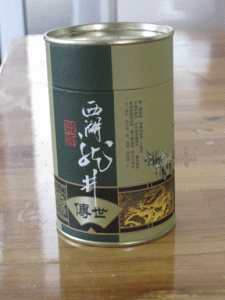
Despite living near Hangzhou for the last two months, I have yet to buy some of the local specialty: Dragon Well Tea. (Pronounced Longjing Cha here in China.) Longjing is not only a famous local tea, but it is one of China’s most famous teas period. In fact, it is the tea served to visiting diplomats and is often called the National Tea in China.
I had seen the bushes, and learned all about the process at the National Tea Museum, yet I hadn’t drank it yet. What a shame, right? So I remedied that when Ryan and I, with a little help from our friend Wendy, bought a small container of the freshly roasted leaves. We bought it in a touristy area (in Hangzhou’s cultural street) and out front of the shop was a man roasting the leaves in a big round wok. The tin of leaves we got was so freshly roasted it was still warm and smelled faintly of roasted nuts.
This is what makes Longjing Tea different then any other type: the roasting. It is hand roasted, with the roasting master using his bare hands to feel the temperature. A true roasting master trains for 3 years to learn the 10 traditional “movements of roasting. The tea is roasted twice the day it is picked. Once to slightly dry the tea while making it attractive, and the second time (after allowing it to cool and dry further) for more drying and to prepare the leaf for drinking. A master tea roaster only roasts 1 kilogram of the best quality stuff a day.
I have no delusion that the stuff we bought was the highest grade leaf, roasted by a master. There are several “tea roasting†shops set up on this street and they go through a lot more than 1 kilo a day. But I enjoyed looking at him roasting it, and smelling the sweet, nutty smell of the roasting leaves. Plus, I figure I am not that sophisticated a tea drinker to be able to tell the subtle taste difference between the a-grade and b-grade stuff.
(Of course, not everyone feels the way I do. One person paid $14,000 for 200 grams of the highest quality stuff. I mean, I like my tea, but that is just plain crazy.)
And how did the tea get the name ‘Dragon Well?’ There is actually a place, called Dragon Well Village, that has the aforementioned well. One legend has it that the water in the well is especially dense, so after a rainstorm, the lighter rain floats on the top and makes a snaking, twisty, dragon shape in the well. The other story is that there is indeed a dragon under the well that ensured the village plenty of good weather with a nice mix of sunny and rainy days.
Ironically, the best Dragon Well Tea is not grown in the Dragon Well Village, but rather around the West Lake (or xihu). But because there is not much land around the West Lake, most of the tea is grown around Zhejiang Province (the area we live in). There is rumor of an “official” tea field that us only used for government officials like the president that is guarded by armed guards. I haven’t seen it yet, but I am keeping my eyes peeled for it!
Hit enter to search or esc to close


can you get me some???
no letters yet…..:-(